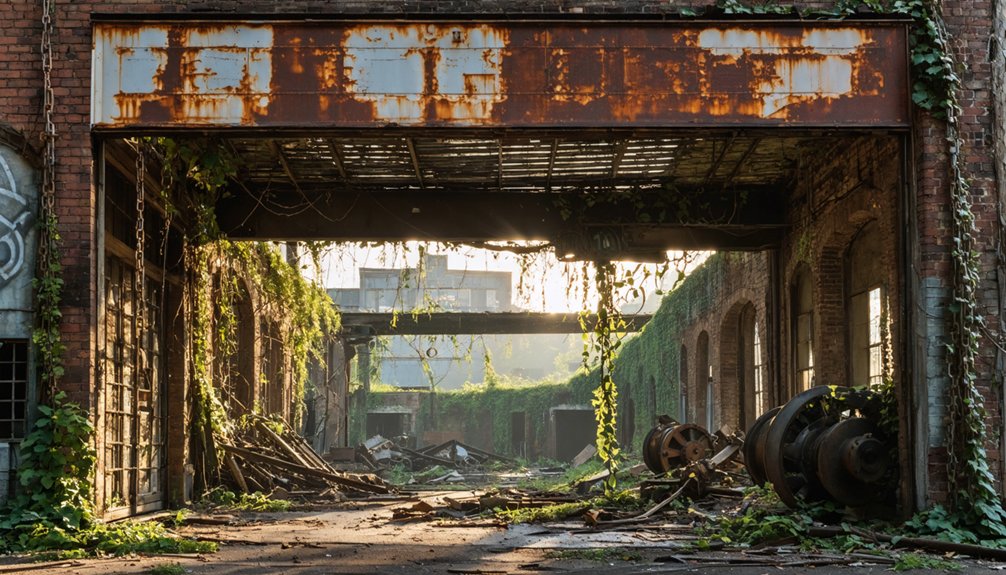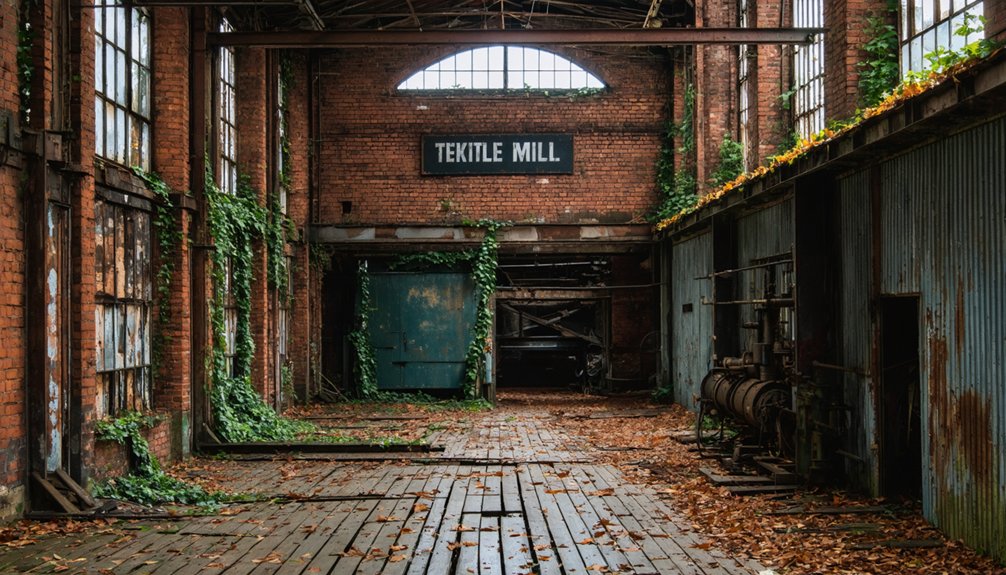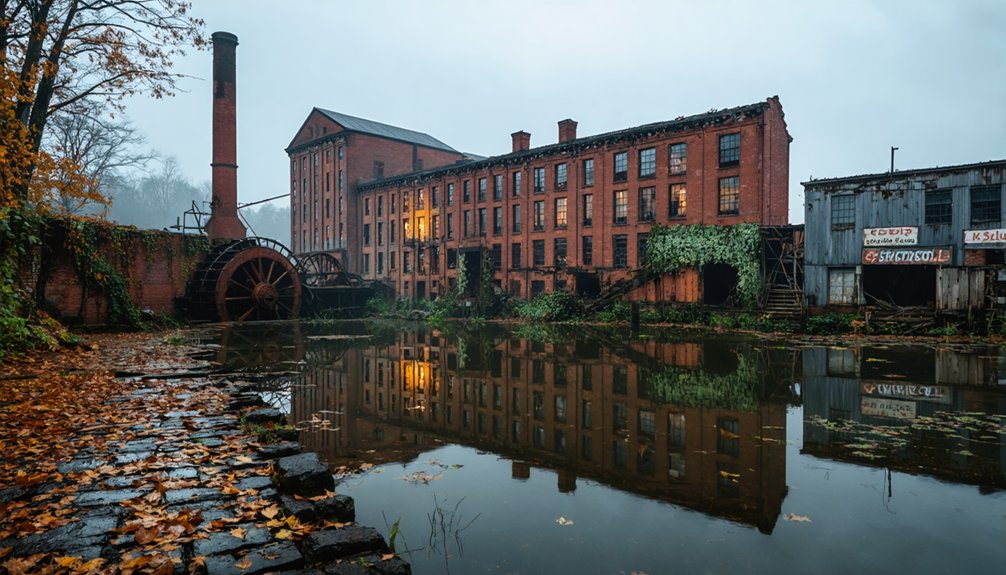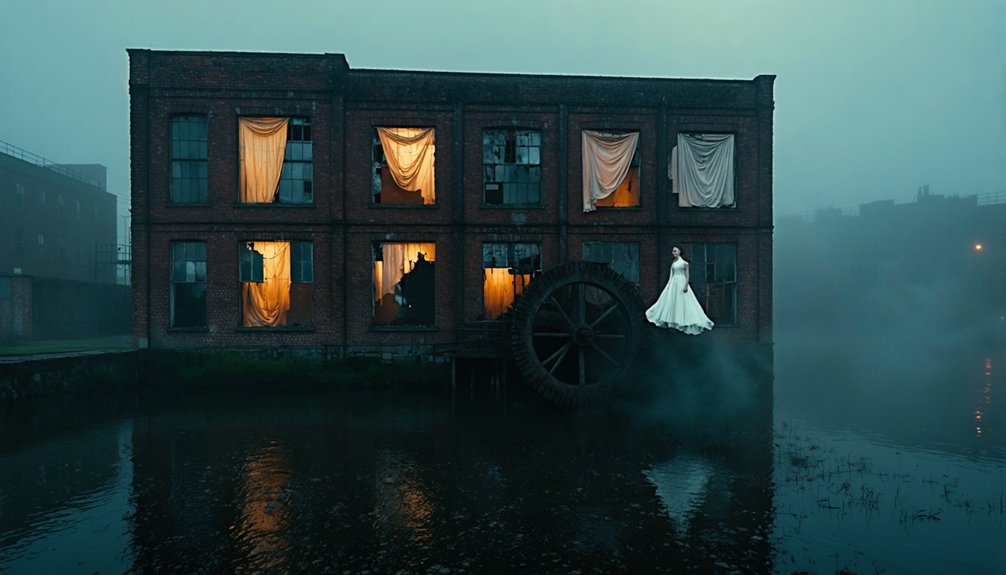When you explore abandoned industrial mill towns, you’re walking through the physical remains of America’s manufacturing history, where nearly 2,000 company-owned communities once controlled every aspect of workers’ lives. These decaying structures—from Lowell, Massachusetts to Henry River, North Carolina—tell stories of 16-hour workdays, child labor, and economic dependency. Today, these industrial ghosts face preservation challenges, including hazardous materials and funding issues. The crumbling facades hold secrets of both exploitation and innovation.
Key Takeaways
- Abandoned mill towns like Henry River Mill Village (North Carolina) and Paterson (New Jersey) offer glimpses into America’s industrial past.
- Urban explorers document these decaying historical sites despite “No Trespassing” warnings, highlighting their cultural and architectural significance.
- Safety hazards include unstable structures, contaminated soil, and hazardous materials requiring caution during exploration.
- Approximately 2,000 former company towns exist throughout America, featuring distinctive industrial architecture and community layouts.
- Adaptive reuse strategies and preservation efforts are transforming some abandoned mill sites into heritage parks and educational venues.
The Rise and Fall of America’s Company-Owned Industrial Communities

As the Industrial Revolution transformed America’s economic landscape in the 19th century, a unique social experiment emerged in the form of company-owned industrial communities.
You’d find these towns sprouting across America’s coal fields, textile regions, and steel-producing areas, with Lowell, Massachusetts standing as the first planned industrial community in the 1820s.
In these isolated enclaves, you’d experience total company control over your life—from the house you lived in to the currency you spent at company stores. Approximately 2,000 company towns have existed throughout American history, ranging from harsh mining settlements to more idealized communities.
Labor relations were notoriously tense, with workers’ attempts to organize often leading to conflicts like the Pullman Strike of 1894, which demonstrated the fragility of these paternalistic systems.
After their peak in the early 20th century—when nearly 80% of West Virginia miners lived in company housing—these towns declined rapidly as New Deal policies undermined their economic model.
Haunting Remnants: What Remains in Today’s Mill Town Ruins
While company towns have vanished as economic entities, their physical remains haunt today’s landscape as industrial ghosts.
You’ll find brick fortresses with stark white trim now crumbling—their doors boarded, windows smashed, and sections completely collapsed from decades of freeze-thaw cycles.
The historical significance of these sites is marred by their dangers. Soil contaminated with poisonous solvents created exclusion zones, while the legacy of 288 accidental blasts that killed 228 people adds to their grim allure.
History’s dark shadow: contaminated grounds and hundreds of explosion deaths make these industrial ghosts both significant and dangerous.
Despite “No Trespassing” warnings, urban explorers seek decay documentation before demolition erases these landmarks forever. These abandoned structures with their decaying machinery tell the story of industries that once thrived.
Some sites now receive professional documentation through authorized access, though complete restoration requires at least $26 million.
These ruins serve as potent reminders of industrial might surrendered to nature and time.
The Broad Brook Company in northern Connecticut represents a perfect example, having been converted to condominiums in the 1990s before being completely sealed off due to hazardous materials discovery.
Life in the Shadow of the Smokestacks: Social History of Mill Workers

Beneath the towering smokestacks that defined America’s industrial landscape, mill workers endured a precarious existence marked by exploitation and hardship.
You’d find entire families trapped in economic dependency, with children as young as seven working 12-16 hour shifts alongside parents just to survive.
Walking through a mill village, you’d witness worker resilience manifested in small acts of cultural resistance—alternative churches, revival meetings, and preserved rural traditions like vegetable gardens amid company-owned housing.
Despite abysmal conditions—overcrowded slum housing where 15 people might share a damp cellar, dangerous machinery causing frequent accidents, and widespread disease—workers created independent social lives. The constant noise from machinery forced workers to develop unique communication methods including lip reading and visual cues.
Supervisors and company police maintained constant surveillance over residents, monitoring behavior both inside and outside the workplace to ensure compliance with mill rules.
Though reform movements eventually brought safety regulations and education requirements, the system kept families indebted to the mills, perpetuating cycles of poverty that defined generations of industrial workers.
Five Must-Visit Abandoned Mill Towns Across the United States
Where can you witness America’s industrial past etched into decaying brick and rusted machinery?
Henry River Mill Village in North Carolina offers a haunting glimpse of textile history, recently immortalized as District 12 in The Hunger Games.
The ghostly remains of Henry River Mill Village whisper stories of looms and labor while Hollywood found dystopia amid its decay.
In Massachusetts, Lowell’s preserved mill complexes and New Bedford’s abandoned textile factories showcase different stages of industrial heritage.
Paterson, New Jersey—once “Silk City”—features dramatic ruins alongside the powerful Great Falls that fueled its rise.
Manchester, New Hampshire houses the massive Amoskeag complex, formerly the world’s largest textile operation before its 1935 closure.
These abandoned sites reveal America’s manufacturing evolution through architectural remnants.
Each location tells a unique story of industrial ambition, worker communities, and economic transformation that shaped our national identity.
Similar to Bodie State Historic Park in California, these mill towns are preserved as snapshots of life during America’s industrial revolution era.
These once-thriving communities now serve as powerful reminders of how economic exploitation ultimately led to their abandonment when resources and profits dwindled.
Preservation Efforts and the Future of Industrial Heritage Sites

As industrial ruins continue to vanish from our landscape, preservation efforts have evolved from simple demolition-or-save decisions into nuanced approaches that balance historical significance with practical reuse.
Modern preservation strategies emphasize adaptive reuse over demolition, with interventions designed to be minimal and reversible.
You’ll find examples of this philosophy at sites like Germany’s Zollverein, where 65 buildings and hundreds of technical facilities remain intact, or Shanghai’s industrial heritage park preserving an entire plant along the Huangpu River.
These projects demonstrate how former industrial spaces can be reimagined while maintaining their authenticity.
The challenge remains in balancing economic development with cultural memory.
Community involvement has become essential in this process—civil initiatives in cities worldwide are advocating for preservation approaches that honor both heritage value and contemporary needs. Studies show that stronger citizen involvement in development processes leads to more successful heritage preservation outcomes. Western hard-rock mining landscapes represent a significant focus area within industrial heritage preservation, requiring specialized approaches that address their unique environmental and historical contexts.
Frequently Asked Questions
How Dangerous Is Exploring Abandoned Mill Towns Without Permission?
Silent as the ghosts that haunt them, abandoned mill towns pose extreme dangers—structural collapse, toxic contamination, and serious legal consequences await urban exploration enthusiasts who trespass, risking injury, death, and criminal prosecution.
What Survival Items Should Urban Explorers Bring to Mill Ruins?
You’ll need multiple flashlights, extra batteries, a thorough first aid kit, water, multi-tool, respirator, gloves, and marking tools—essentials that protect your freedom to explore while managing the inherent risks of decaying structures.
How Did Company Towns Handle Crime and Law Enforcement?
You’d be shocked to learn company towns wielded private police forces as weapons against dissent. Company policies blurred with law enforcement, controlling residents through biased policing, evictions, and suppression of organizing activities.
Were There Successful Worker Rebellions Against Company Control?
You’ll find few successful labor uprisings against company towns. While worker solidarity emerged in strikes like Dover (1828) and the 1934 General Textile Strike, most rebellions ended in defeat and worker repression.
What Rare Artifacts Are Commonly Found in Abandoned Mill Towns?
You’ll uncover rare time cards, forgotten personal belongings, and vintage machinery with manufacturer markings intact. Historical documents like company ledgers and employee records provide invaluable glimpses into lives controlled by industrial powers.
References
- https://www.smithsonianmag.com/travel/americas-company-towns-then-and-now-180956382/
- https://millmuseum.org/history-2/sweat-of-their-brows/rural-communities/
- https://www.richmondfed.org/publications/research/econ_focus/2023/q3_economic_history
- https://en.wikipedia.org/wiki/Company_town
- https://scholarworks.umass.edu/bitstreams/1eaf620d-a116-4f66-b9ea-40cab10cc6f2/download
- https://socialwelfare.library.vcu.edu/organizations/labor/company-towns-1890s-to-1935/
- https://www.brookings.edu/wp-content/uploads/2018/04/2018-04_brookings-metro_older-industrial-cities_full-report-berube_murray_-final-version_af4-18.pdf
- https://philadelphiaencyclopedia.org/themes/workshop-of-the-world/
- https://heritagecalling.com/2021/11/16/9-interesting-facts-about-life-as-a-19th-century-mill-worker/
- https://prospect.org/2018/03/21/company-towns-still-us/



